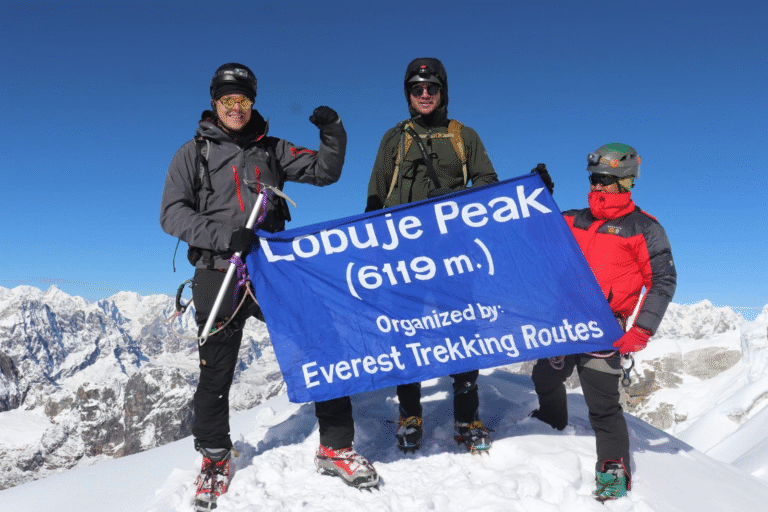Nepal, nestled in the lap of the Himalayas, is a haven for trekkers and mountaineers. Among the towering 8,000-meter giants like Everest and Lhotse, Nepal also offers several “trekking peaks”—mountains that provide thrilling yet accessible climbs for adventure seekers. Among the most popular are Lobuche Peak, Mera Peak, and Island Peak. These three summits offer diverse climbing experiences, stunning Himalayan panoramas, and a profound sense of achievement for those who scale their heights.
1. Lobuche Peak: The Technical Climber’s Choice
Located near the Khumbu Glacier and not far from Everest Base Camp, Lobuche Peak is a favorite for those looking for a technically demanding climb. There are two summits: Lobuche East (6,119m) and Lobuche West (6,145m). Most commercial expeditions aim for Lobuche East, as Lobuche West is considered more challenging and requires special permits.
Climbing Experience
Lobuche East is known for its steep snow and ice sections, narrow ridges, and crevassed slopes. Climbers usually begin from Lobuche village, acclimatizing along the Everest Base Camp route. The final summit push requires the use of fixed ropes, ice axes, and crampons—making it more technical than Mera or Island Peak.
Highlights
- Offers spectacular views of Mount Everest, Lhotse, Ama Dablam, and Nuptse.
- Great preparation peak for future 7,000m+ or 8,000m expeditions.
- Combines cultural richness of the Khumbu Valley with alpine adventure.
2. Mera Peak: The Highest Trekking Peak in Nepal
At 6,476 meters (21,247 feet), Mera Peak is the highest trekking peak in Nepal. Located in the Hinku Valley, south of Mount Everest, Mera offers a less technical climb but demands excellent fitness and acclimatization due to its altitude.
Climbing Experience
Though considered non-technical, Mera Peak involves glacier travel, snow climbing, and ropework near the summit. The ascent is gradual but long, and most climbers use a high camp at around 5,800m. The biggest challenge is the altitude, not the technicality.
Trekkers usually start their journey with a flight to Lukla, then diverge from the Everest route toward Paiya and Tangnag. This remote and scenic trail ensures fewer crowds, enhancing the wilderness experience.
Highlights
- From the summit, climbers can witness five of the six highest mountains in the world: Everest, Lhotse, Makalu, Cho Oyu, and Kanchenjunga.
- Excellent for first-time climbers looking for a high-altitude adventure.
- Offers pristine landscapes, including forests, glaciers, and remote Sherpa villages.
3. Island Peak: The Classic Himalayan Climb
Island Peak (6,189 meters), also known as Imja Tse, is one of Nepal’s most climbed trekking peaks. It was named “Island Peak” by Eric Shipton in 1953 because it appears like an island in a sea of ice when viewed from Dingboche.
Climbing Experience
Island Peak is more technical than Mera Peak but less so than Lobuche. The route includes a rock scramble, glacier crossing, and a steep headwall to the summit ridge. Fixed ropes and harnesses are required in the final sections. The climb is often added as an extension to the Everest Base Camp trek, making it ideal for those combining trekking with mountaineering.
The approach goes through the Khumbu Valley, passing through famous villages like Namche Bazaar, Tengboche, and Dingboche before heading into the Imja Valley.
Highlights
- Striking views of Lhotse, Makalu, Baruntse, and Ama Dablam.
- A popular peak for mountaineering courses and training.
- A manageable climb for fit trekkers with some basic alpine experience.
Best Time to Climb
The best seasons for all three peaks are pre-monsoon (March to May) and post-monsoon (late September to early November). These months offer stable weather, clear skies, and better climbing conditions. Winter climbs are possible but require experience and more robust gear due to severe cold and snow accumulation.
Preparation and Permits
All three peaks require a climbing permit from the Nepal Mountaineering Association (NMA), along with a Trekking Information Management System (TIMS) card and national park entry permits. Climbers should be prepared with proper gear, including crampons, harness, helmet, ropes, and suitable clothing. Many choose to climb with guided expeditions, which offer logistics, experienced guides, and medical support.
Physical fitness is crucial. Training should begin months in advance and include cardio, strength training, and hiking with a weighted backpack. Familiarity with basic mountaineering techniques like rope handling, glacier travel, and crevasse rescue is a bonus—especially for Lobuche and Island Peaks.
Conclusion
Whether you’re a novice adventurer eyeing your first Himalayan summit or a seasoned climber seeking technical challenge, Lobuche Peak, Mera Peak, and Island Peak offer unforgettable experiences. Each mountain provides a unique lens into Nepal’s breathtaking alpine world—combining culture, adventure, and natural beauty in one of the planet’s most awe-inspiring settings. With the right preparation and respect for the mountains, these peaks can be the gateway to the grand world of high-altitude mountaineering.
Contact Details
———————
Company address: Everest Trekking Routes Pvt. Ltd.
16 Khumbu, Nayabazaar, Kathmandu, Nepal
Mobile : +977-9843467921 (Rabin)
Email: [email protected]
URL:- www.everesttrekkingroutes.com

